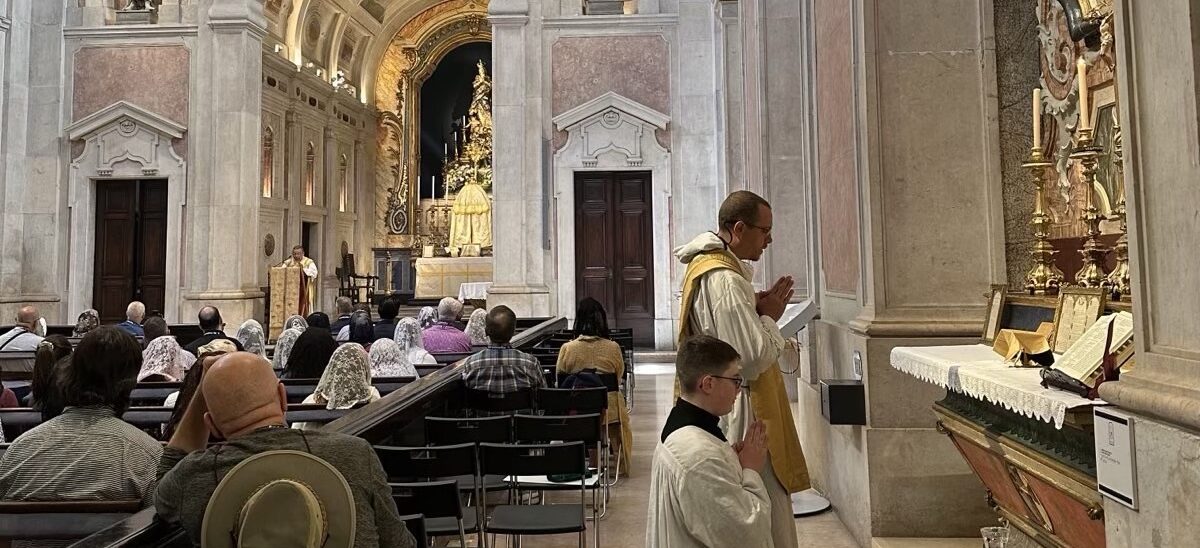The three grades (so to speak) of the Traditional Latin Mass (TLM) are listed in order of ascending solemnity:
Low Mass: In this Mass, a lay person will probably just hear the priest whisper the Roman Canon without a choir or any chanting. The above featured-image is me offering Holy Mass at a side altar in Portugal. Notice that I have a server in that picture, but I never have a server in my hermitage for my daily low Mass. Only two candles are lit upon the altar, whether the priest has a server or not. Of course, in a low Mass it is still God the Son offering Himself to God the Father (even if it’s just God and the angels with the priest.) As you will see below, the Low Mass is a newer grade flowing from the Solemn High Mass, but not as high in solemnity. Of course, even the low Mass is over a thousand years older than the Novus Ordo. There are no “con-celebrants” in this “low Mass” or any other grade of the ancient TLM for that matter. Also, a low Mass may often be a Missa Privata (a private Mass) which simply means it’s not publicized. In fact, a low Mass can still be considered a private Mass with many faithful in attendance, provided it’s not publicized.
Missa Cantata is the “Sung Mass” in English. It is offered by only one priest (no deacon or sub-deacon) but it still has a choir, unlike the Missa Privata. It also has more servers or acolytes than a low Mass. You’ll often see this sacrifice as the main High Mass at an SSPX or FSSP parish on Sundays. Six candles are lit upon the altar. Most people think this is the “dialed-down” Solemn High Mass, but it’s actually the “dialed-up” Missa Privata as we will see in the second half of this blog from Fortescue.
Missa Solemnis is a “Solemn High Mass” in English. This is the highest of all the Roman Rite, but it’s also the norm of it in the first millennium of Christianity in Rome. There is an amazing picture book for the TLM (made for both children and adults) called Treasure and Tradition that explains the following about how the Solemn High Mass is offered: “A priest-Celebrant presides, assisted by a Deacon (who sings the Gospel and the Dismissal) and a Subdeacon (who sings the Epistle.) A thurifer and an even number of acolytes are also required, as well as a crucifer and torchbearers for processions… The propers must be sung by the choir, or at the very least by a cantor, and incense is used several times throughout. Six candles are to be lit upon the altar, with a seventh added if the Mass is celebrated by a Bishop, in which case it is termed a Pontifical High Mass.”
The old school Catholic Encyclopedia quoted by the Bastion explains how the norm of the Roman Rite is actually found in the full Solemn High Mass in its most ancient form:
“This [Solemn] High Mass is the norm. It is only in the complete rite with deacon and subdeacon that the ceremonies can be understood. Thus, the rubrics of the Ordinary of the Mass always suppose that the Mass is high. Low Mass, said by a priest with one servant [acolyte] alone, is a shortened and simplified form of the same thing. Its ritual can be explained only by reference to high Mass… A sung Mass (Missa Cantata) is a modern compromise. It is really a low-Mass, since the essence of high Mass is not the music but the deacon and subdeacon. Only in Churches which have no ordained person except one priest, and in which high Mass is thus impossible, is it allowed to celebrate the Mass (on Sundays and feasts) with most of the adornment borrowed from high Mass, with singing and (generally) with incense.”—From the Catholic Encyclopedia, Vol. IX, 1910, p.799 containing an article by Msgr. Adrian Fortescue on the Mass.
Dr. Peter Kwasniewski recently emailed me on the history of this, too: “The sung Solemn High Mass was the norm for many centuries, whenever and wherever it could be done. Remember, like the East, the West initially didn’t celebrate Mass daily. When solemnity is your main goal, you can’t necessarily pull it off every day. Later, early Middle Ages, priests wanted to say a daily Mass whether or not they were participating in a solemn Mass later in the day, so the private low Mass got going. It is identical to a solemn Mass in the sense that the priest ‘takes over’ all the tasks and texts of the solemn Mass, doing them and saying them by himself. Later still, a desire to sing Mass meant that the low Mass began to be sung. What Americans call the High Mass and Brits call the Sung Mass (and any of us can call Missa Cantata) is a low Mass chanted.”
Thus, the Solemn High Mass with three clerics (never concelebrating, all in different roles) and a choir or schola is what we traditionalists should all be aiming for, especially if we desire to return to the early Church in Rome and the Medieval Church. They really weren’t that different.
